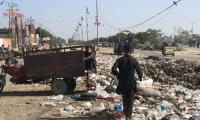Every survey done since the promulgation of the Prohibition (Enforcement of Hadd) Order, 1979, shows that our nation has persistently sunk deeper into narco-terrorism – a term signifying the nexus between drug trade and terrorism.
The terrorism-drug trade nexus – since the 1980s – not only resulted in over nine million addicts in 2017, but also led to the emergence of many organised criminal gangs that deal in drugs and weapons, kidnappings for ransom, target killings, speed money, extortion and financing terrorists. This unholy alliance between organised crime and terrorist outfits has been causing serious internal security threats to the state.
If the figures recently made available by the official agencies are even close to half the truth, the monstrous legacy of Zia’s misrule should be identified as the biggest continuous threat to Pakistan’s future. Not confined to Karachi alone, many groups have over the years been involved in corruption; land grabbing; smuggling of drugs, currency and Iranian oil; unlawful collection of zakat, fitrana, sacrificial hides and protection money; carrying out targeted killings; setting up illegal marriage halls and parking spaces; fixing matches and committing cybercrimes etc. Part of the ill-gotten money from these criminal activities is used in funding terrorist outfits.
Statistics reveal that in 1980 Pakistan had 5,000 heroin addicts – hardly any in 1979 – out of a total of about 124,000 drug users. Within eight years of Zia’s regime their number increased by more than 200 times to one million, and the total number of drug addicts reached 2.2 million. Since then there has been an alarming increase of more than 10 percent per year. In 2017, the total number of addicts was estimated to be not less than nine million, out of which heroin users were about 3.5 million.
It does not require an expert opinion to convince any concerned citizen that this epidemic is ruining the very fabric of our society. The phenomenal increase in trafficking and local consumption of heroin has been witnessed after the promulgation of the Hadd Order in 1979. That year Pakistan had a bumper crop of poppy on some 80,000 acres of land, and the total yield was an all-time record of 800 metric tons. Figures obtained a day prior to the imposition of the Hadd Order recorded opium selling at Rs1,200 per kg in Punjab. A day later, the prices shot up to Rs9,000 per kg in the province.
Left with a surplus of opium, the dealers did not know what to do with their stocks. At that time, international drug smugglers came to their rescue. Within a few months the growers were happy that their opium stocks would not be wasted and they would earn 10 times more by converting them into heroin. The birth of heroin in Pakistan and its local consumption portrays the tragic consequences of our decision-makers’ short-sightedness. Pakistan proves a horrible example of a country that was converted into a ‘kingdom of heroin’ within a short span of time.
As decided by the UN General Assembly in 1987, June 26 is annually observed as the international day against drug abuse and illicit trafficking, to raise awareness in the international community about the dangers of drug abuse, prevent its spread and encourage all efforts to combat the menace at an international level. Each year the UNODC selects a theme. This year’s theme is: ‘Let’s develop our lives, our communities, our identities, without drugs’.
The UNODC – based in Islamabad – has been working in Pakistan for over 35 years. Its official website says that during the Zia period, domestic and regional conflict, as well as social, political and economic troubles exacerbated the drug trade and crimes in the region. Prominent transnational criminal industries operating from, in and through Pakistan include drug trafficking, precursor trafficking, arms smuggling, human trafficking and migrant smuggling. According to the UNDOC, Pakistan is now the destination and transit country for approximately 40 percent of the opiates produced in Afghanistan.
Most processing takes place in small, mobile laboratories in Af-Pak border areas, although increasing instances of processing have also been reported from the Afghan areas bordering Central Asian republics. The sub-region itself has become a major consumer market for opiates. Opiate processing on both sides of the Af-Pak border has been creating a trafficking and, most importantly in the case of Pakistan, drug abuse problem since the early 1980s. The UNODC estimates that 40 percent of the drugs (heroin and marijuana) originating in Afghanistan are routed through Pakistan to China, the Gulf States, Africa and Europe.
The 2018 International Narcotics Control Strategy Report (INCSR), annual report presented by the US Department of State to the Congress, mentions that, “Significant money laundering predicates in the country include tax evasion, fraud, corruption, trade in counterfeit goods, contraband smuggling, narcotics trafficking, human smuggling/trafficking, and terrorist financing. The black market, informal financial system, and permissive security environment generate substantial demand for money laundering and illicit financial services”.
The report goes on to observe: “Money laundering in Pakistan affects both the formal and informal financial systems. The Pakistan-Afghanistan border is largely unregulated, which facilitates the flow of illicit goods and monies into and out of Pakistan. Due to their distance from urban centres and the lack of comprehensive regulatory oversight, border areas – such as the jurisdiction of Chaman and the Torkham Gate area – see illicit financial activity by terrorist organisations and insurgent groups, such as money laundering by the Taliban.
“In fiscal year 2017, the Pakistani diaspora remitted $19.3 billion to Pakistan via the formal banking sector, up a modest 1.4 percent from the previous year. Though it is illegal to operate a hawala or hundi without a licence in Pakistan, the practices remain prevalent due to a lack of access to the formal banking sector, poor supervision and regulation, and a lack of penalties levied against illegally operating businesses. Unlicensed hawala/hundi operators are also common throughout the broader region and are widely used to transfer and launder illicit money through neighbouring countries.”
Although Pakistan continues to face enormous economic and security challenges which often exceed narcotics trafficking in national security priorities, many of these challenges are interconnected. Pakistan could more effectively reduce drug trafficking if its law-enforcement agencies coordinated more closely, shared information more readily and expended limited resources more efficiently.
Increased public awareness about the drug trade and its negative societal influences will further enhance the Pakistani government’s concerted actions across law-enforcement agencies.
The writer specialises in studying global heroin economy. He has written two internationally acclaimed books on the subject, Pakistan: From Hash to Heroin and its sequel Pakistan: From Drug-trap to Debt-trap.
Email: ikram@huzaimaikram.com
Twitter: @drikramulhaq
After November 30, it will be impossible for ordinary internet users to access all banned websites, including X
Muslims participated alongside their Hindu fellow villagers and other residents of area
For last eight years, HEC's budget has been virtually stagnant in absolute terms
Home to 14 million people, Lahore has always been celebrated as Pakistan’s historical, culinary, and cultural hub
Partnership between Pakistan and China in media and culture reflects shared commitment to strengthening bilateral...
This article focuses on single error committed by our respected judiciary which haunts me more than I would care to...







